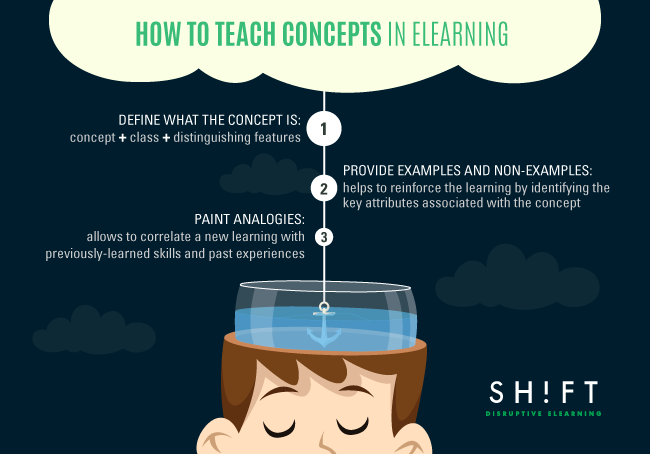Concepts are knowledge tools that identify, define, explain, analyze, and demonstrate real-life elements and events. These are broad ideas that are in many instances, true across geographical and cultural boundaries.
There are two kinds of concepts: sensory and abstract. The characteristic features of sensory concepts are tangible, can be picked by one or more of our sensory organs, and are apparent in any example you may pick up. For instance, a course for trainee physicians to help them learn how to diagnose diseases will mostly deal with sensory concepts. On the other hand, some features of abstract concepts are neither visible nor tangible. Courses on people management and leadership often contain abstract concepts.
As an instructional designer, you will have to teach both sensory and abstract concepts. Here’s a three-step process to help you teach concepts:
Step #1: Define
In a nutshell, it is the answer to the universal question that crops up in our minds whenever we embark on to learn something new. What in the world is that? The definition is the most critical component when explaining concepts.
A definition is a statement of facts that identifies the specific class that the subject belongs to and specifies its unique characteristics. Understandably, a definition should state only the distinguishing traits that help you differentiate between the subject and other members of its class. So to elaborate, a definition consists of two parts:
- The class of the object, or the genus
- The difference that contains the distinguishing traits of the object
Here's a definition: Diablo is a video game (genus or class) with role-playing action (difference).
Let's analyze this definition. It effectively identifies the class of Diablo as a video game. But the difference is too generic and it does not help you differentiate Diablo from any other video game like Minecraft, Super Mario, or War of the Worlds because these games too have role-playing action.
Now consider the above definition with a few more details thrown in: Diablo is a video game with hack and slash role-playing action.
This definition has not only identified the class Diablo belongs to but has also distinguished it from other role-playing action games like Super Mario.
Step #2: Provide Examples and Non-Examples
You can remember a definition by memorizing it. But this knowledge is not adequate to help you understand a concept and apply it in your reality. Providing examples along with the definition helps cement the learning by identifying the key attributes associated with the concept. You can use as many examples to elaborate an idea; usually one suffices for simple concepts. Besides, using examples to explain concepts helps learners categorize objects based on similar properties. Being able to categorize is a higher mental process that enhances the engagement value of your eLearning course.
A non-example is more or less similar to the concept but contains one or more different attributes. Providing both examples and non-examples elaborates the concept and helps learners figure out what attributes are relevant to the concept under consideration and which are not.
Instructional designers! Here's what you should keep in mind when creating examples and non-examples to teach concepts:
- Ensure that you club them, so they remain together in the working memory for easy recall.
- Create examples and non-examples that reflect the reality of the learners.
For instance, in a course to teach fire safety, create an example using a fire scenario where the employees of an office building have to be escorted down the stairs to be evacuated. Also create a non-example using a fire scenario where the fire is spreading upwards through the floors. In this case, the scenario should include learning tips like escorting the employees to the roof of the building from where they can be rescued by helicopters. Of course, in the non-example, take care that you explain how this fire scenario is different from the other one and merits a different evacuation plan.
3. Paint Analogies
Analogies jog the memory of the learner and help him/her correlate a new learning with previously-learned skills and past experiences. Analogies are excellent instructional tools to explain abstract or complex concepts. They impart familiarity and relevance to the concept and make learners more receptive to the material. Using analogies enhances comprehension, improves retention, and ensures there is no misunderstanding.
Here's how you can build an analogy:
- Mull over and identify a familiar concept that you want to relate to the idea the learner is about to be introduced to. Tip: Make sure you carry out a thorough research of target audience demographics to learn about their past learning experiences. After all, you cannot build an effective analogy by referring to an object or a procedure that the learner is not familiar with.
- Define both the elements. Tip: Choose elements—objects and situations—from the learner's daily life.
Here's an example:
Food is to the body what gasoline is to the car.
Just as you need to use impurities-free fuel to keep the car engine running in top-notch condition, you have to put the right foods in your body to be healthy.
Concepts form the foundation of every new skill that the learner wants to acquire. It is your responsibility that you facilitate a smooth learning experience that helps the learner make a seamless switch from the desk to the workplace.
REFERENCES
Castañeda Yañez M. (2010) Análisis de conceptos y procedimientos. Editorial Trillas.
Information Mapping. (2012). Guía del Participante para el curso Desarrollo de Políticas, Procedimientos y Documentación.
Peralta Caballero A, Olvera Sánchez A, Cuevas Manzanares A.




